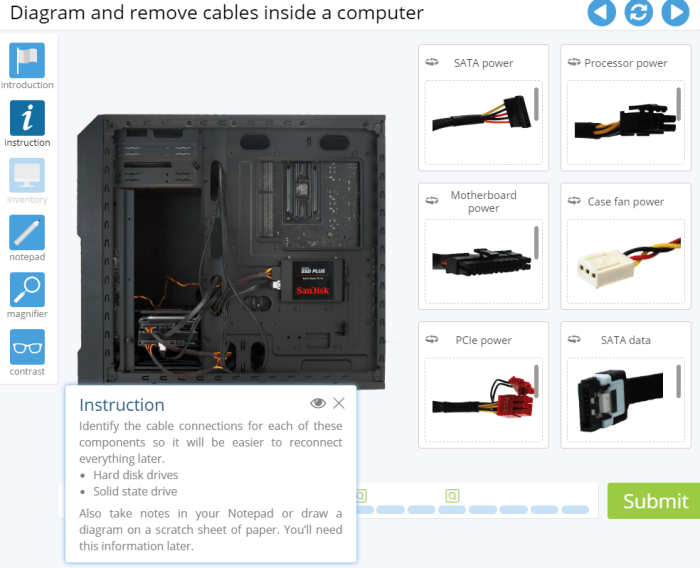Hardware lab simulation 3-1 installing processor and connecting power – Embarking on a journey into the realm of computer hardware, we delve into the intricacies of Hardware Lab Simulation 3-1: Installing Processor and Connecting Power. This comprehensive guide will illuminate the steps involved in this crucial process, empowering you with the knowledge to tackle these tasks with confidence and precision.
Delving into the core of a computer’s functionality, we will explore the types of processors and their significance. The intricacies of installing a new processor will be meticulously dissected, ensuring a seamless transition and optimal performance. Furthermore, we will unravel the complexities of connecting power to the motherboard and its components, addressing potential pitfalls and providing troubleshooting techniques.
Hardware Lab Simulation 3-1: Installing Processor and Connecting Power

This lab simulation provides a virtual environment for students to practice installing a processor and connecting power to a computer system. By completing this simulation, students will gain hands-on experience with these essential hardware tasks.
Installing the Processor
Processors, also known as central processing units (CPUs), are the brains of a computer. They are responsible for executing instructions and managing the flow of data within the system.
- Types of Processors:There are various types of processors available, including Intel Core i series, AMD Ryzen series, and Apple M series.
- Removing the Old Processor:Before installing a new processor, it is necessary to remove the old one. This involves carefully lifting the lever on the processor socket and gently pulling the processor out.
- Installing the New Processor:Align the new processor with the socket and carefully insert it into place. Make sure to apply even pressure and avoid touching the delicate pins on the processor.
Connecting Power, Hardware lab simulation 3-1 installing processor and connecting power
Power is essential for a computer to function. It is supplied by a power supply unit (PSU) and distributed to various components through power connectors.
- Power Connectors:The main power connector is the 24-pin ATX connector. Other common connectors include the 4+4-pin CPU power connector and the 6+2-pin PCI-Express power connector.
- Connecting the Power Supply:Connect the 24-pin ATX connector to the motherboard and the CPU power connector to the CPU socket. If necessary, connect the PCI-Express power connector to the graphics card.
Safety Precautions
It is crucial to follow safety guidelines when working with computer hardware. Failure to do so can result in damage to components or injury.
- Grounding Yourself:Touch a metal surface or wear an anti-static wrist strap to discharge any static electricity before handling components.
- Avoiding Electrostatic Discharge (ESD):Handle components carefully and avoid touching sensitive areas to prevent ESD damage.
- Proper Workspace:Work on a clean, flat surface and use a non-conductive mat to prevent short circuits.
Troubleshooting
If problems occur during the installation process, it is important to troubleshoot the issue.
- Processor Not Detected:Ensure that the processor is properly seated in the socket and that the CPU power connector is securely connected.
- No Power:Check that the power supply is turned on and that all power connectors are firmly attached.
- Diagnostic Tools:Use diagnostic tools such as POST (Power-On Self-Test) codes or motherboard beep codes to identify hardware problems.
FAQ Resource: Hardware Lab Simulation 3-1 Installing Processor And Connecting Power
What are the different types of processors used in computers?
Processors come in various types, including Intel Core i3, i5, i7, and i9, as well as AMD Ryzen 3, 5, 7, and 9. Each type offers varying levels of performance and features.
How do I avoid damaging the processor during installation?
Handle the processor with care, avoiding touching the gold pins. Use an anti-static wrist strap and work on a grounded surface to prevent electrostatic discharge.
What are the common power connectors used in computers?
The main power connector is the 24-pin ATX connector. Other common connectors include the 4/8-pin CPU power connector, 6/8-pin PCIe power connector, and SATA power connector.

